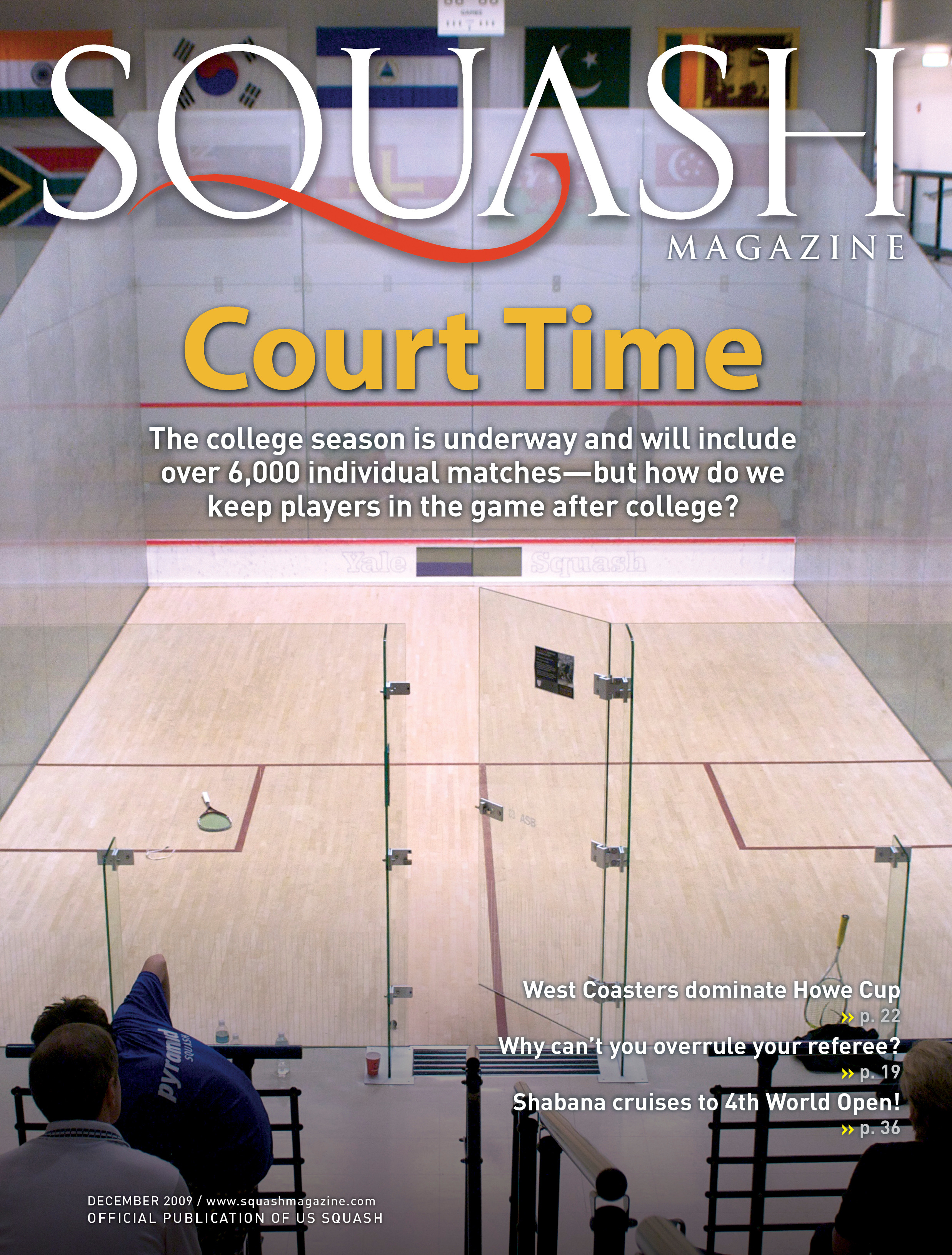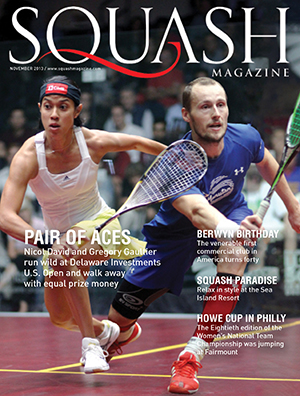Railing on PAR
From my own experience on the amateur level I think PAR scoring has not been working very well. From my point of view it has taken out of the game the key ingredients of mental toughness and physical endurance. It has also made some matches less interesting as players are encouraged by the scoring system to go for winners rather than developing a point.
I played squash in college and am currently an A-level player at the club level (rated somewhere between a 5.5 and 6.0), and belong to a couple of squash clubs in the NY metropolitan region.
In tournament situations my experience in my own matches and in observing other matches is that the average time for a match has probably gone down to about 30-35 minutes versus 45-60 minutes under traditional scoring (these are just rough guesses). I have played in a couple of matches where the match was over in 20 minutes. My daughter has also played in a couple of very short matches of about 20 minutes and I have even seen one junior girls match go the distance in less time than that.
Under traditional scoring, the fact that you could only win on serve made matches longer and tougher. Also under traditional scoring, a player always felt he/she could come back and have a chance to win. Now, if you are down 9-6 or 10-7, for example, the feeling is that there is little chance to win that game. On the other side of the equation, if you are up by those same scores, there is every incentive to go for winners as your odds of getting one or two are fairly high and you will be able to close out the game easily by doing so. This has shortened rallies and made the points in my view less interesting.
The argument that amateur squash should have the same scoring as pro squash (apparently for Olympic aspirations?) also seems an odd one to me. It may be that the Olympic committee suggested this as a means to strengthen the sport’s position in the eyes of the OC, but other sports don’t aspire to such uniformity. Tennis is one example, where the major tournaments for men require best of 5 sets whereas almost all college, high school and club tournaments require best of 3. And yet, tennis is in the Olympics. Rugby was admitted to the Olympics this year, and yet the games played at the Olympics will, I believe, consist of smaller teams and different rules than those played in the current major rugby tournaments.
A couple suggestions: In addition to simply reverting to traditional scoring, another option is to make it PAR 15 versus PAR 11 scoring at the amateur level. This would at least lengthen the games a little and bring back the element of fitness and mental toughness (this doesn’t eliminate entirely however the problem of going all out for winners to close out a game when in the lead). Also, obtain a more objective handle on the effect the new scoring system is having on the game. Survey college and high school coaches who have the best objective view on how the new scoring system is affecting play for their kids. I’ve spoken to a couple of coaches, one a prominent high school coach and another a college coach, and they don’t believe PAR scoring is working very well for the same reasons I have highlighted. Also, most of my playing partners that I have spoken to about the scoring system (young college kids and older players) think the traditional scoring was better. As a community, let’s find out what the data shows and what the coaches think and find the best outcome.
Gary Beeson
via Email
Very good article and a subject that still causes debate amongst my fellow pros and club members. Firstly, going five minutes with no score under HiHo-9 is awesome! A good test of wills and patience which is how one plays softball! I wouldn’t look for instant gratification to win easily. Secondly, I’ll always have the highest respect for a fellow pro friend who years ago played Jahangir Khan in a Bundesliga league match and lost 0,0,1. But it took 45 minutes! Lastly, if you go down 2-8 or 2-9 under PAR there’s little chance of coming back; you’d have to play perfectly. But under HiHio-9, you can be down 2-7 or 2-8 and come back to win because you’re holding the serve. I appreciated this.
And yes, I for one miss the more skilled and shot-varied hardball game and the exciting WPSA (joined with ISPA to form PSA to save the game in the U.S.) hardball Tour that it was!
Eric Christiansen
via Email
I’m a 60 yr old geezer who’s been playing squash since college, mostly at our little club west of Sacramento (CA). I’ve played in several national Masters competitions, and plan to again this year in Rhode Island.
I balked at softball years ago, but quickly learned to enjoy and appreciate it. I can’t say the same for PAR. We’ve been playing it for about a year now, since all the tournaments require it. The games to 11 go much faster than the old scoring to 9. Since my partners and I want at least an hour-long workout, we play PAR to 15 so the matches last about the same time. But in tournaments, it will obviously be to 11 and even a close match will probably be over in 45 minutes.
The main difference though is in the mentality the two systems foster. In 9 point, you tended to never feel you were out of a match. You could pull your way back into it a point or two at a time. Conversely, a lead never seemed that safe because you’d have to win two points in a row after a side-out to finish it off, and that could be difficult. Now with a big lead, it’s easier to feel you’ve got it made because surely the other guy is going to make a couple errors to end the game.
I’m not saying PAR is better or worse, it’s just that the mindset is totally different. All my partners feel the same way. I can see why it was instituted for pros when their conservative rallies would lead to 90 minute matches, but for the run-of-the-mill amateur, I think the old scoring made it a little more difficult and competitive to come out on top.
Dan Dougherty
via Email
I would like to second the points made in readers’ letters in support of traditional HiHo scoring. In particular, I thought David Brail really hit the nail on the head in his letter in the December edition. Tenacity is indeed one of the best virtues of the game, and the kind of comebacks from deep deficits that he describes have certainly provided some of the most dramatic squash moments that I have been a part of or witnessed. And I share his concerns that this will be lost or greatly diminished by PAR scoring.
Tom Roddis
via Email
I am the administrator for a Squash League here in Minneapolis. We are a group of about 80 people, who compete monthly for both exercise and ranking within our group.
Without any question, PAR matches are shorter on the average than HiHo—and there is the main problem. First off, if you are either mismatched or just having a bad (or good) day, the 3-0 match can be very, very quick and thus very disappointing. I agree that most people play on till the time is complete (1 hour at our clubs), but it is not the same kind of play. Second, I think having the point on the line every rally changes some of the subtlety of the game. When I am serving in HiHo I can play a bit more aggressively knowing that a mistake will not cost the point. Maybe not great form, but I enjoy that aspect of HiHo. Third, what may be good for the pros, does not automatically mean it is good for us (average age 40-45) league players. The pros have longer rallies, and completely different time constraints on their tournament matches. Lastly, I hate losing a game, or match on a bad serve—not that it happens much to me (yeah, right), but it has and it sucks.
Many sports have different rules for professional play and amateur. Tennis at our club is a 3-set match for both men and women. Not so in the pros. I play city league hockey and we don’t check, and play 15 minute periods (to accommodate the 1 hour ice time). Other examples could also be found.
We put it up for a vote in the league and HiHo won with about a 10% margin. I decided to let folks choose match by match, having HiHo as the default if they could not agree.
Douglas Smith
via Email
In the Massachusetts inter-club leagues PAR scoring is now mandated. Like most players I did not like the change, but I have noticed at least one positive characteristic.
At my level (only 3.5), with PAR scoring an opponent is less likely to attempt a high risk “winning” serve. In HiHo-9 the risk of serving “out” is less punitive, so a higher percentage of points result in a frustrating 3-hit rally: good serve, weak return, winning shot. With PAR there is more chance of getting into a longer rally (which is more fun, unless I’m really tired).
It would be easy to conduct a statistically significant “scientific” study to contrast the number of 3-hit rallies using the different scoring systems at each ranking level. Good use of stimulus funds?
Richard Wynne
via Email





